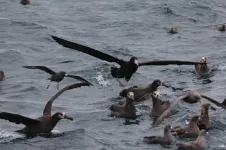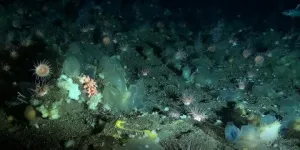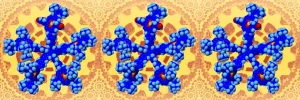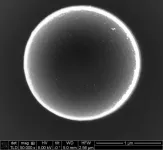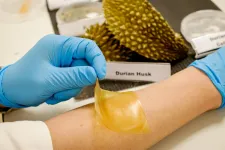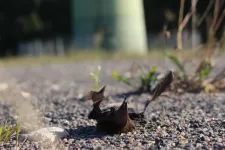(Press-News.org) CORVALLIS, Ore. - A novel analysis of encounters between albatross and commercial fishing vessels across the North Pacific Ocean is giving researchers important new understanding about seabird-vessel interactions that could help reduce harmful encounters.
The new research method, which combines location data from GPS-tagged albatross and commercial fishing vessels, allows researchers to accurately identify bird-vessel encounters and better understand bird behavior, environmental conditions and the characteristics that influence these encounters.
"It is hard to conceptualize how often birds encounter vessels in the open ocean, but with this new data, it becomes really apparent," said Rachael Orben, an assistant professor in the Department of Fisheries and Wildlife in Oregon State University's College of Agricultural Sciences and the study's lead author. "Some of these birds are in an environment where they see vessels all the time, while others are in an environment where they rarely encounter vessels."
The findings were just published in the Journal of Applied Ecology. Co-authors include Leigh Torres, an associate professor at OSU's Marine Mammal Institute, and David Kroodsma, director of research and innovation for Global Fishing Watch, a not-for-profit organization dedicated to advancing ocean governance through increased transparency of human activity at sea.
Albatross are large, long-lived seabirds that roam widely over the open ocean. Three albatross species are found in the North Pacific: the black-footed albatross, the Laysan albatross and the short-tailed albatross. All three species are of high conservation concern and the short-tailed albatross is listed as endangered under the Endangered Species Act.
Fishing activity can offer the birds opportunities for foraging, but not without risks, including threat of bycatch. Bycatch is the term for fish, birds or other animals caught unintentionally and includes interactions with fishing vessels and fishing gear.
Researchers have been using biologging, the practice of attaching data recording devices to animals, to track individual bird movements at sea for more than 20 years. But they have not had much access to information about the location of vessels, which is a critical piece to understanding the seabird-fishery interaction puzzle, Torres said.
Torres learned that Global Fishing Watch was processing and making available data from the Automatic Identification System, or AIS, an automatic tracking system that uses transceivers on ships. The data includes information about vessel size, movement, fishing method and more. Access to the data was a "game-changer," she said.
"With their data, you can track individual vessels," Torres said. "You can get precise information about a vessel's location, its size, the type of fishing gear it is using and the flag nation of the ship."
Global Fishing Watch's goals include making commercial fishing on the high seas more transparent to the public, improving fisheries regulation and ensuring sustainability of ocean resources.
"This study represents a new frontier in our ability to understand how fisheries impact marine life," said David Kroodsma, director of research and innovation at Global Fishing Watch. "Vessel tracking data, collected by satellites and processed with machine learning, can be a powerful tool to analyze how biodiversity and fishing vessels interact at sea."
Members of the research team had previously collected albatross tracking data from adult black-footed albatross and Laysan albatross breeding in the Papahānaumokuākea Marine National Monument in the Northwest Hawaiian Islands; Laysan albatross nesting on Oahu, Hawaii; and juvenile short-tailed albatross originating from their colonies in Japan.
The researchers were able to marry data on fishing vessels with tracking data from the GPS-tagged albatross during the same periods to identify and locate where bird-vessel interactions occur throughout the North Pacific Ocean.
When birds are within 30 kilometers of a vessel, the researchers assumed the albatross was aware of the vessel's presence, Orben said. When the bird was within 3 kilometers of the vessel, researchers assumed a close encounter between the two. The research team then modeled the drivers of these close encounters.
"With these models, we can start to understand why birds sometimes do and sometimes don't interact with a fishing vessel," Torres said. "This information can help identify how and when efforts should be made to make sure these interactions don't go wrong for the bird. As we start to identify patterns, we can potentially help mitigate these bycatch events."
Among the researchers' findings:
When birds are in a transit state - where they are traveling directly from one location to another - they are not likely to stop and engage with a vessel. But when they are in a foraging state, they are more likely to stop.
Vessel characteristics, including fishing method and the nation of flag on the vessel did not seem to be factors in whether a bird interacted with a vessel.
In areas where there is a lot of fishing, short-tailed and Laysan albatross associated with fishing vessels more frequently.
Short-tailed albatross were more likely to stay with a vessel for a longer period of time in lighter wind conditions.
"These results indicate that it may be more important to use bycatch mitigation methods from a fishing vessel in low wind conditions," Torres said. "Things like that can help guide efforts to reduce bycatch of seabirds. The best regulations are those that are the least burdensome to fishermen and the most effective."
The analysis framework developed by the researchers could be used to study encounters between fishing vessels and other seabirds or marine mammals. Information gathered through the study of these interactions could help inform fisheries management decisions, as well, the researchers said.
"Our study is really one of the first to look at the fine-scale overlap between fishing vessels and marine animals on the high seas, in international waters," Torres said. "It opens a whole new understanding of the dynamics between animals and vessels. This work can help the fishing community fish better and help these seabirds survive and thrive."
INFORMATION:
The research team included albatross researchers from the U.S. Geological Survey, Oikonos Ecosystem Knowledge, San Jose State University, NOAA Fisheries, Yamashina Institute for Ornithology, Pacific Rim Conservation, San Diego State University and Stony Brook University.
For the first time, researchers from the SponGES project collected year-round video footage and hydrodynamic data from the mysterious world of a deep-sea sponge ground in the Arctic. Deep-sea sponge grounds are often compared to the rich ecosystems of coral reefs and form true oases. In a world where all light has disappeared and without obvious food sources, they provide a habitat for other invertebrates and a refuge for fish in the otherwise barren landscape. It is still puzzling how these biodiversity hotspots survive in this extreme environment as deep as 1500 metres below the water surface. With over 700 hundred ...
Ikoma, Japan - Gear trains have been used for centuries to translate changes in gear rotational speed into changes in rotational force. Cars, drills, and basically anything that has spinning parts use them. Molecular-scale gears are a much more recent invention that could use light or a chemical stimulus to initiate gear rotation. Researchers at Nara Institute of Science and Technology (NAIST), Japan, in partnership with research teams at University Paul Sabatier, France, report in a new study published in Chemical Science a means to visualize snapshots of an ultrasmall ...
People who are physically active on a regular basis recover better after surgery for colorectal cancer. However, starting to exercise only after the diagnosis is a fact had no effect on recovery, a University of Gothenburg thesis shows.
In working on his thesis, Aron Onerup, who obtained his doctorate in surgery at the University's Sahlgrenska Academy and is now a specialist doctor at Sahlgrenska University Hospital, carried out an observational study of 115 patients diagnosed with colorectal cancer.
The participants who had been physically inactive proved, three weeks after their surgery, to be at higher risk of not feeling that they ...
Microswimmers are artificial, self-propelled, microscopic particles. They are capable of directional motion in a solution. The Molecular Nanophotonics Group at Leipzig University has developed special particles that are smaller than one-thirtieth of the diameter of a hair. They can change their direction of motion by heating tiny gold particles on their surface and converting this energy into motion. "However, these miniaturised machines cannot take in and learn information like their living counterparts. To achieve this, we control the microswimmers externally so that they learn to navigate in a virtual environment through what is known as reinforcement learning," said Cichos.
With the help of virtual rewards, the microswimmers find their way through the liquid ...
Food scientists from Nanyang Technological University, Singapore (NTU Singapore) have made an antibacterial gel bandage using the discarded husks of the popular tropical fruit, durian.
Known as the "King of Fruits" in Southeast Asia, the durian has a thick husk with spiky thorns which is discarded, while the sweet flesh surrounding the seeds on the inside is considered a delicacy.
By extracting high-quality cellulose from the durian husks and combining it with glycerol - a waste by-product from the biodiesel and soap industry - NTU scientists created a soft gel, similar to silicon sheets, which can be cut into bandages of various shapes and sizes.
They then added the organic molecules produced from baker's yeast known as natural yeast phenolics, making the bandage deadly ...
In order to assess the risk of bats dying at wind turbines, it is common practice to record the acoustic activity of bats within the operating range of the rotor blades. For this purpose, ultrasonic detectors are attached to the nacelles of the mast top. In a recent analysis, a team of scientists led by the Leibniz Institute for Zoo and Wildlife Research (Leibniz-IZW) concludes that the effectiveness of this acoustic monitoring is insufficient to reliably predict mortality risk, especially for bats at large turbines. They therefore recommend installing supplementary ultrasonic detectors at other locations on the wind turbines and developing additional techniques such as radar and thermal imaging cameras for monitoring. The results of their analysis are published in ...
European listed companies in the energy and mining sector provide, to say the least, sparse information on future environmental costs in their annual reports. Researchers believe that stricter guidelines are required as the lack of information may lead to underestimation of environmental liabilities, resulting in that future generations may have to bear the burden of cleanup costs.
"I believe that the future environmental liabilities such as decommissioning costs are often underestimated and few understand the burden these costs might impose on future generations. If, for example, an oil & gas company fails, it costs an incredible amount to clean up after old oil wells and the risk is great that the taxpayers will have to pay the bill. Therefore, it is important that environmental obligations ...
Increased allergic reactions may be tied to the corticotropin-releasing stress hormone (CRH), suggests a study published this month in the International Journal of Molecular Sciences. These findings may help clarify the mechanism by which CRH induces proliferation of mast cells (MC) - agents involved in the development of allergies in the human nasal cavity.
"In my daily practice, I meet many patients with allergies who say their symptoms worsened due to psychological stress," states lead researcher Mika Yamanaka-Takaichi, a graduate student of the Department of Dermatology, Osaka City University, "This is what led me to do this research."
Together with Professor Daisuke Tsuruta of the same department, they hypothesized that due to its ...
Bright but disadvantaged students from urban areas are more likely to enter elite UK universities than similar peers from rural communities due to an urban 'escalator effect', according to a new study.
Researchers from the University of Bath analysed data from 800,000 English students commencing university in the years 2008, 2010, 2012, 2014 and 2016.
They found that while in general rural areas had higher overall progression to university than city centres and surrounding areas, when controlling for factors including socio-economic status, age, ethnicity and sex, disadvantaged pupils from rural areas were less likely to progress to one of 27 'top' UK universities.
The authors suggest the difference ...
NIMS and RIKEN have succeeded in synthesizing the longest ever bottlebrush polymer. This polymer--resembling a green foxtail--is composed of a main chain and numerous side chains grafting from it. The team also succeeded in giving various chemical properties to the ultralong bottlebrush polymer. These achievements are expected to substantially advance the current synthetic methods of bottlebrush polymers. This technique may be applicable to the development of flexible and low-friction polymeric materials.
In the development of polymeric materials, it is necessary to link molecular units with desired chemical properties, called monomers, to ...
